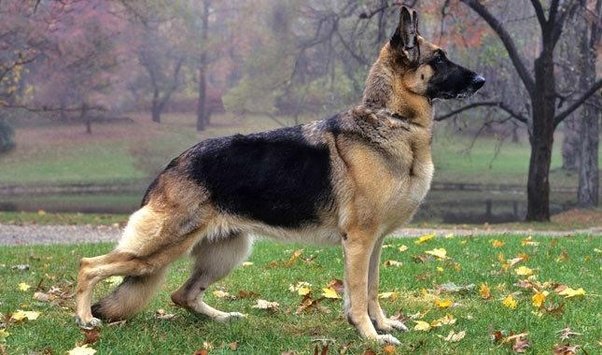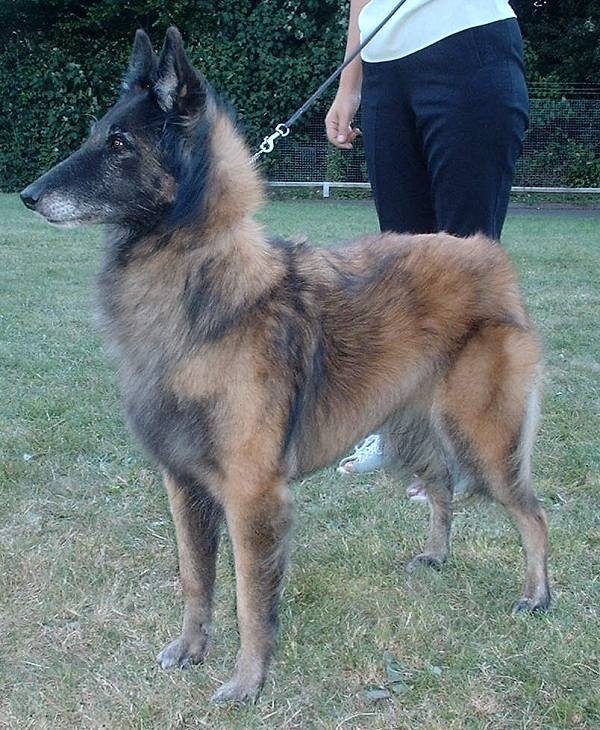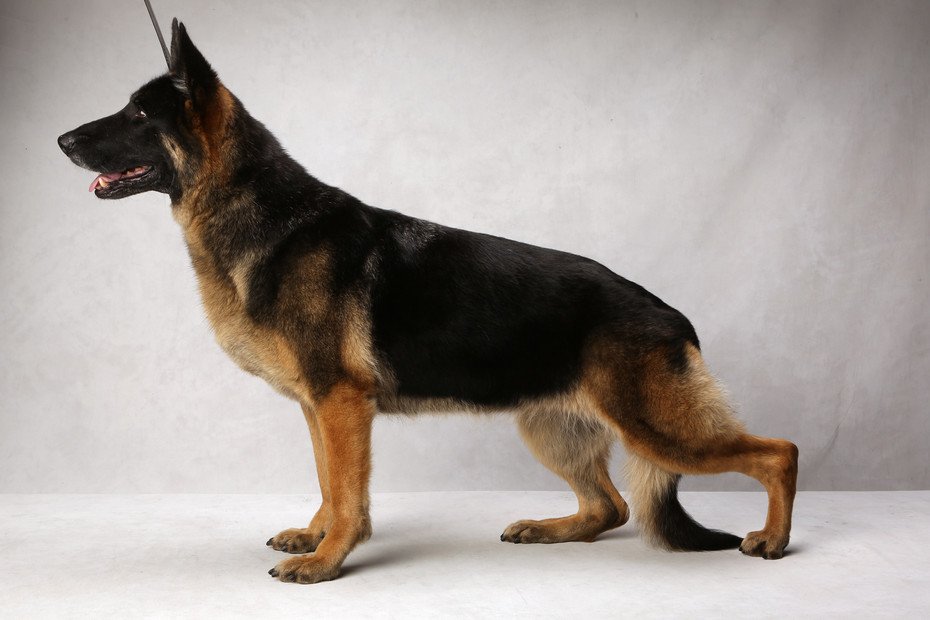Should A German Shepherd Have A Straight Back Or A Sloped Back
Canto von der Wienerau
This is perhaps one of the most most debated topics of the German Shepherd breed. Should the shepherd have a straight back or a sloped back.
People all over the planet get very bent out of shape and emotional when trying to discuss the shepherds back. Some people say the straight back looks awful. Others call the sloped back a mutilation or deformity due to bad breeding. There is, however, one things nearly everyone discussing this has in common: complete ignorance.
Dont Miss: How Big Do German Shepherd Beagle Mixes Get
It Is In Their Wolf Ancestry
In the wolf world where dogs have their ancestry, staring is rude and threatening. So, when your dog stares at you continuously, he might be manifesting an evolutionary holdover from his ancestral roots and communicating some displeasure. And if the uninterrupted hard stare is directed to a stranger, they should back away and not stare back!
What Is The Difference Between A Straight Back And A Sloped Back German Shepherd
Citing the difference between a straight back and a sloped back GSD, reveals the dynamics of breeding German Shepherds. This dog breed has undergone a number of transformations. Although, some breeders have tried to keep the original line, other breeders have focused more on the physical attractiveness of the GSDs. These different focuses have made a division within the GSD breed.
Don’t Miss: When Do German Shepherds Ears Stand Up
White Swiss Shepherd Dog
The White Swiss Shepherd Dog is a variety of the German Shepherd bred in Switzerland. It descends from the American White Shepherds the first stud dog of what became the breed was an American dog born in 1966 and imported to Switzerland. The variety was recognised by the Fédération Cynologique Internationale as a separate breed in 2003, and it is now recognised by a number of national kennel clubs.
How Can You Tell If Your Dog Has Hip Dysplasia

Weakness and pain in the hind legs are the usual clinical signs. The dog appears wobbly and is reluctant to rise from a sitting or lying position. Some dogs will limp or be reluctant to climb stairs. These signs can be seen in puppies as early as a few months old but are most common in dogs one to two years of age.
Don’t Miss: Is My German Shepherd Too Skinny
Is A Straight Back German Shepherd Better
A straight-back German shepherd is definitely superior in terms of its physique when compared to other German shepherd breeds. This is mainly due to their hind legs which are often longer and easier to stretch.
As a result, German shepherds with straight backs are more active and agile than their sloped back counterparts.
Moreover, they are inherently less prone to getting health issues over the years due to not having exaggerated backlines.
Sloped back German shepherds can suffer from various health concerns such as joint issues, hip dysplasia, etc. due to the unnatural shape of their backs.
Bear in mind, however, straight-back German shepherds can also run into similar health problems if they are not given proper care and maintenance.
Why Do Dogs Hind Legs Collapsed
Degenerative myelopathy initially affects the back legs and causes muscle weakness and loss, and lack of coordination.
These cause a staggering affect that may appear to be arthritis.
The dog may drag one or both rear paws when it walks.
This dragging can cause the nails of one foot to be worn down.
The breed was named Deutscher Schäferhund by von Stephanitz, literally translating to “German Shepherd Dog”. The breed was so named due to its original purpose of assisting shepherds in herding and protecting sheep This name was also adopted by many other international kennel clubs.
Read Also: How Much Exercise For German Shepherd
Why Do German Shepherds Nibble
Nibbling is the gentle bite your dog will make on your body, especially on your toes! This German Shepherd behavior is generally considered an instinctual behavior characterizing puppies of all breeds, especially during teething.
When young puppies play, you will have noticed that they will display behavior consisting of gently biting each other as part of the game. Your doggo can transfer this nibbling behavior to you or your furniture if no other puppies or pets are around, which is why teething toys such as the KONG Puppy Toy from Amazon are essential. You can even stuff it with treats or peanut butter to keep your GSD entertained.
But German Shepherd Dogs tend to bring this growing up behavior into their adult life. Naturally, newborn German Shepherd puppies will explore their world with their mouths before using their sight and smell. And it appears that this instinct is maintained throughout life for important reasons, as shown by some studies.
A study investigating the meaning and emotion associated with nibbling in dogs concluded that the behavior is not related to negative personality traits. Instead, nibbling has two functions:
Despite these facts, nibbling behavior in German Shepherds can also be triggered by several other factors:
Assess Their Laying Spot
It seems that your German Shepherd doesnt trust the safety of his bed or lying spot. It will also circle the spot to ensure there are no vermin or harmful objects that will make your pets rest uncomfortable.
There is little scientific data to prove the above 3 examples except for the idea that dogs circle before lying down to make a nest. This small study of 62 dogs implied that dogs are more likely to circle before lying down when given a soft, uneven surface to make a temporary nest to sleep in.
Don’t Miss: Training Your German Shepherd
What Does A Straight Back German Shepherd Mean
The straight-back German shepherd is the oldest breed of German shepherd dogs. The term Straight back refers to their distinctive skeletal physique.
They are generally defined as the working line of German shepherds because they were primarily bred for safeguarding cattle. These dogs have a flat back and dont have angulated hindquarters like other German shepherd breeds.
The formal lineage structure of these dogs was introduced in the late 19th century and by the early 20th century, they were growing in popularity in America and winning positions in dog shows. Their agile and vigilant nature also made them perfect for guard duty.
Nowadays, youll find German shepherds all over the world working as part of the police and military for various purposes such as search and rescue dogs, K9 operations, and guide dogs for people with disabilities.
Straight-back German shepherds also make for excellent family pets because of their devotion and loyalty.
How Long Do Dogs Last With Hip Dysplasia
Dogs with hip dysplasia can live comfortably, long into their golden years, so even if your dear canine has been diagnosed with the condition you can expect many joyful years together. If your dog is over 7 years old, they may need additional support as they age read more about caring for a senior dog here.
Read Also: Why Do Police Choose German Shepherds
German Shepherds Back Legs Problem Solution
Hip dysplasia has no specific treatment. The goal of treatment is to reduce discomfort and improve joint function. The effectiveness of treatment is determined by the severity of the condition.
Mild-to-moderate hip dysplasia may be controlled with light exercise, a nutritious diet, and oral pain medications such as buffered aspirin or Rimadyl, as prescribed by the veterinarian.
Moderate exercise keeps your German Shepherd muscle tone in check and improves it. This reduces joint wear and strain.
Back legs problems in dogs can be treated in various ways, ranging from lifestyle changes to surgery. Your veterinarian may propose a nonsurgical option if your dogs hip dysplasia is not severe, or if your dog is not a surgical candidate for medical or economic reasons. The vet may recommend the following, depending on your dogs situation:
- Weight loss to relieve stress on the hips
- Restriction of exercise, especially on hard surfaces
- Physical therapy
- Medications that reduce inflammation
- Modifiers of joint fluid
Persuade your dysplastic Shepherd to accompany you on short walks. Swimming is a suitable exercise, but jumping and racing for long periods should be avoided.
Obesity enhances joint strain and can worsen the problem, so keep your Shepherd light. Massage can also improve the dogs mood.
What Is A Sloped

Some German shepherd breeders are not into much of this dogs working abilities. Rather, they are more satisfied with its appearance or looks. Thus they opt to have sloped back German shepherds.
Such sloped-back German shepherds tend to have exaggerated slope back lines. And if you look at their hips and knees, they are close to the ground, making this dog have angulated hindquarters.
Such a physique is present in Showline German shepherds.
Don’t Miss: German Shepherd Puppy Drawing Easy
Common Problems With German Shepherd Back Legs
German Shepherds are a dog breed that is often mentioned when it comes to mobility issues especially in their older years. Mobility is an important consideration when it comes to taking care of your dog. Not only does it affect most of the normal daily activities that the dog is able to perform, but mobility issues can affect the dogs mood, appetite, and quality of life. Therefore, in this article, we explore some of the common German Shepherd back leg problems.
Why Are My Dogs Back Legs Slipping Out
This is a complaint Ive heard many times in the vet clinic from people facing a change in their dogs mobility. The most common causes for an older dogs back legs collapsing, slipping out or hind leg weakness are osteoarthritis, intervertebral disc disease, lumbosacral disease and degenerative myelopathy.
You May Like: How Long Should I Feed My German Shepherd Puppy Food
What Causes Short Spine Syndrome In Dogs
The condition, which is thought to be caused by inbreeding, causes the vertebrae of the spine to remain in a more cartilage-like state instead of strengthening into bone. As a result, some of the vertebrae fuse together, restricting movement. This compression of the spine leads to a shortened spine.
Read Also: How Many Puppies Can A German Shepherd Have First Litter
What Are The Clinical Signs
The typical symptom is a sudden, unexplained, painful lameness of one or more legs. The lameness may be mild or severe. The most common bone that is affected is the humerus , but panosteitis may also be found in the radius and ulna , the femur and/or the tibia . The affected bone will be painful to the touch. Other symptoms such as fever, anorexia, lethargy, or weight loss may be noticed.
Panosteitis tends to have a cyclic nature, with periods of worsening symptoms followed by periods of improvement. The pain often shifts from leg to leg. Each episode of lameness may last for a few days to a few weeks, and the period between episodes is often about a month, but may vary.
Read Also: Pitbull Versus German Shepherd
Why Do German Shepherds Lick Other Dogs
The affection and communication reasons discussed earlier why your German Shepherd Dog licks you also apply to his licking other dogs and pets. Below is a photo of my female German Shepherd Willow licking the face of her Boxer dog friend. Looks like he was more interested in the forthcoming treat!
But did you know that in the doggie world licking behavior also has a dominance element?
People who have lived in a multi-dog household know that one dog may lord it over the other and will access things first, , always win fights, go for attention first from the owner, and receive more licks from their subordinates.
In a study on dog dominance, licking their subordinates less was one of the indicators of dominance in 83% of dogs rated as dominant by their owners.
Why Do Gsd Breeders Have To Health Test Their Parent Dogs
As the Canine Health Information Center points out, most purebred dog breeds today have certainly known potentially heritable health issues that occur more commonly in those dog breeds.
This is because these dogs have been closely bred to conform to either a working or show breed standard. When this happens, the breeder is deliberately selecting parent dogs based on certain desirable traits rather than on overall health.
When this type of breeding program is pursued, it can lead to genetic weaknesses that are passed along to the puppies.
For the German Shepherd dog breed, the major known genetic weaknesses that responsible breeders are required to test for include these:
- Hip and elbow dysplasia.
- Degenerative myelopathy.
- Eye issues.
These are not insignificant issues, and the most concerning in terms of the sloping back many show line German Shepherds show today is hip and elbow dysplasia.
Dysplasia is a word that is used to describe cellular malformation on a wide scale. When applied to the hip or elbow socket, it refers to a socket that doesnt fully conform to the ball joint.
When a German Shepherd inherits hip or elbow dysplasia, what this means is that the dogs hip or elbow joints wont form properly and the dog will be lame. The condition can range from mild to crippling.
Don’t Miss: What Size Crate For German Shepherd
How To Treat Dysplasia In German Shepherds
Last Updated: May 15, 2019ReferencesApproved
This article was co-authored by Pippa Elliott, MRCVS. Dr. Elliott, BVMS, MRCVS is a veterinarian with over 30 years of experience in veterinary surgery and companion animal practice. She graduated from the University of Glasgow in 1987 with a degree in veterinary medicine and surgery. She has worked at the same animal clinic in her hometown for over 20 years.There are 14 references cited in this article, which can be found at the bottom of the page.wikiHow marks an article as reader-approved once it receives enough positive feedback. In this case, 100% of readers who voted found the article helpful, earning it our reader-approved status. This article has been viewed 13,029 times.
German Shepherds are large, lovable dogs. They are also intelligent, protective, and athletic.XResearch source Unfortunately, German Shepherds are prone to developing a joint condition called dysplasia in their elbows and hips in fact, nearly 20% of German Shepherds will develop hip dysplasia during their lifetimes.XResearch source If your German Shepherd isnt able to move around like he used to, he may have dysplasia and will need veterinary treatment.
Using Surgery To Treat Dysplasia

Don’t Miss: How Much Raw Meat To Feed My German Shepherd
A German Shepherd That Is Not Black Can Produce Black German Shepherd Puppies
Yes, you heard right. A German Shepherd that is, say, black and tan, can carry the recessive solid black gene and produce Black German Shepherd puppies. However, both parents must have the recessive gene for solid black to appear in the litter. So if you go to meet your puppy and see that the parents arent solid black, dont be surprised! It can happen. The second way solid Black German Shepherd puppies are produced is by mating two solid blacks. This mix can only produce a solid black litter.
Are There Any Preventive Measures I Can Take To Prevent Panosteitis In My Large Breed Dog
Although there are potential links between diets containing excessive levels of dietary protein and/or calcium, it is contraindicated to feed large breed puppies with an adult dog food that contains lower levels of protein and calcium. The reason for this is that adult dog food also has lower calories or energy levels than puppy food. Rapidly growing puppies require higher levels of dietary energy to meet the needs of growth, and will need to eat more of a low-energy food to meet these requirements. Eating more of a low energy diet will result in a higher overall intake of protein and calcium.
A better option is to feed an affected dog a high quality diet that has been specifically formulated for use in large breed puppies or adolescents, and to restrict the quantity fed to keep the dog at a lean, healthy body weight. Do not allow your puppy to become overweight. Consult your veterinarian for further advice on the most appropriate nutrition for your dog.
Don’t Miss: Best Collars For German Shepherds